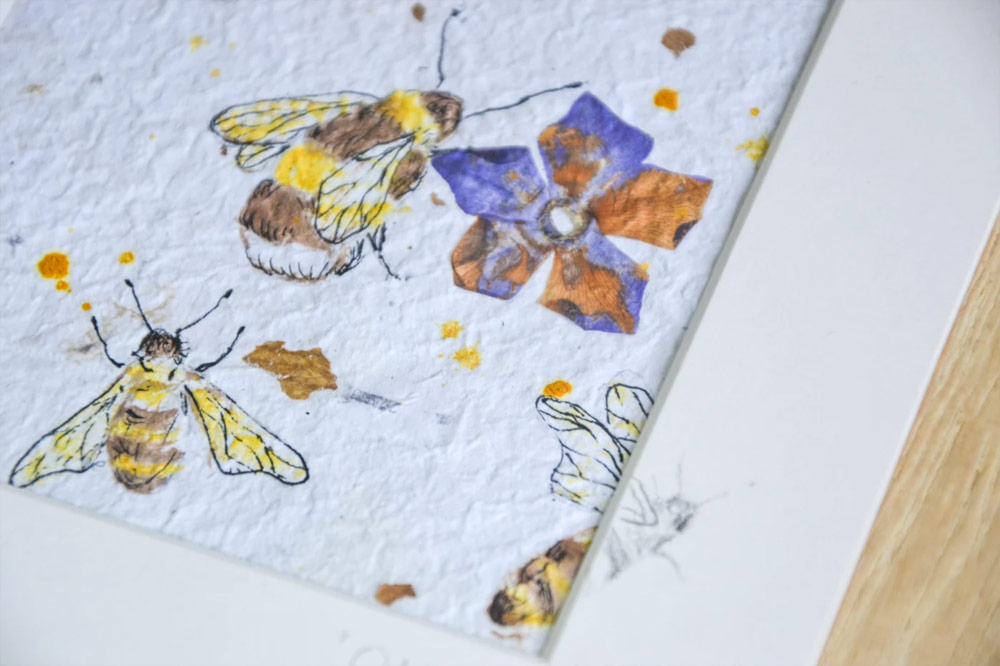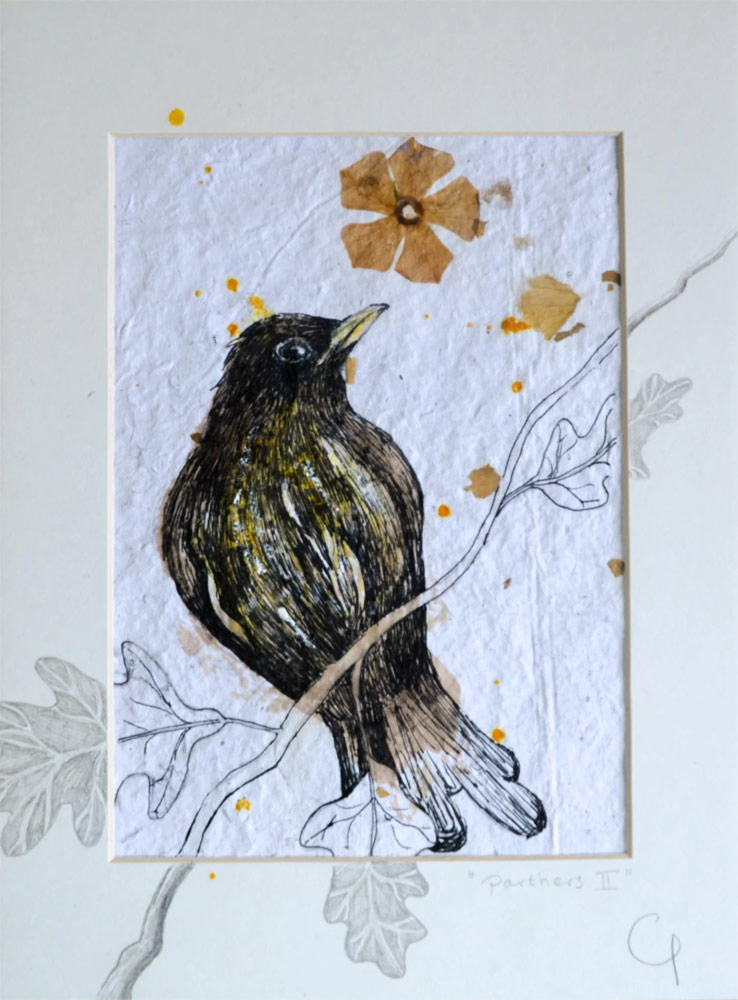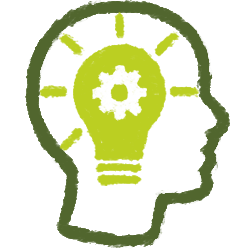Example of Footprint mapping
As a side effect of the COVID-19 pandemic, an in-person workshop to explore this project no longer seemed feasible, and after carrying out other elements of stakeholder engagement, it wasn’t clear if there would be much benefit to the research at this stage. I also wanted to thank the individual artists in particular for the time and thought they offered through being interviewed.
I was aware of emerging multimedia artist Catriona Patience’s work across craft, painting and photography and her aspirations to create work aligned with nature in both theme and content. This seemed like a perfect opportunity to commission her to try out some new ideas in the production of five small pieces for each of the artists I’d interviewed.
Catriona used this commission to experiment with creating pigments and paper from things that would otherwise have gone to waste. She made paper from junk mail, incorporating textures from foraged flowers that she dried, using a kitchen blender and specific drying frames. Pigments to enhance her ink and pencil images were made from coffee, black beans and turmeric.
Catriona Patience Paintings
I provided Catriona with anonymised words that interviewees had used to describe changes they made in response to climate change and she chose those which resonated with her own work and interest in the natural environment to create five beautiful works. These were the paintings Catriona created, and below are her words about each.
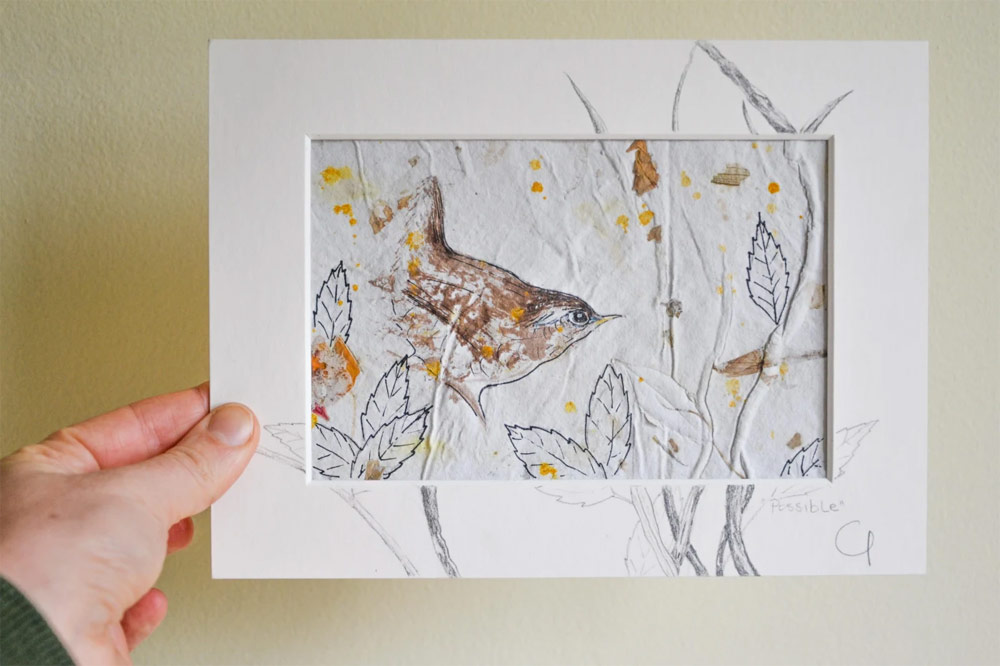
possible
Possible: Wren in Winter
“Wrens are the UK’s second smallest bird. They often do not survive harsh winters which can lead to dramatic decreases in population; despite this wren populations soon recover. ”
Odd One Out: Honeybees and queen white-tailed bumblebee
“The whole life cycle of bumblebees depends on the queens, which hibernate through the winter and form new nests in the spring.”
Relief: Dandelion and queen buff-tailed bumblebee
“I liked the idea that climate friendly practices might not require a lot of effort and can actually bring relief for people and nature. Mowing lawns less frequently, for example, allows plants such as dandelions to flower, providing food for pollinators as well as involving less work for people. I thought of Karine Polwart’s song ‘Take its own Time’.”
Partners: Female blackbird and Partners II: Male blackbird
“Blackbirds mate for life, and are one of our most common urban and garden birds. The word partners also made me think of how the natural world is made up of complex, nuanced partnerships between species and how even the behaviour of blackbirds in a garden can allow you to glimpse this interconnectedness. I felt I should include both partners!”
Papermaking
Part of the purpose of this commission was to experiment with making paper from waste paper. Catriona reflected that in using foraged flowers and leaves and drying them to use them, she noticed the impact of the weather on the whole process. Even indoors, drying flowers and ultimately paper, simply takes longer on a dreich day! That vulnerability and requirement to work with nature has its beauty but also its cost in time, which can be a challenge for an independent maker and artist.
There was also the challenge of having to get the images ‘right’ first time, or adjust what ‘right’ was as the works came into being. When it’s a labour and time intensive process to create the paper and the paper becomes an integral and artistic part of the finished work, the process is different compared with being able to take a new piece of paper if something doesn’t go right. Catriona carried out a number of development sketches and trials with the pigments on waste paper before committing marks to the paper she’d made specifically for the works.
Footprint Mapping
Part of the value of this commission was to understand the process from the perspective of its environmental impact. Catriona used a qualitative approach to mapping the carbon footprint that I’ll evaluate in more detail in another post to provide a framework for the emissions from her work. First, I asked Catriona to identify emissions sources in her work. Below you can see the different emissions she was aware of in the process of creating the art works and, within that, the papermaking specifically.
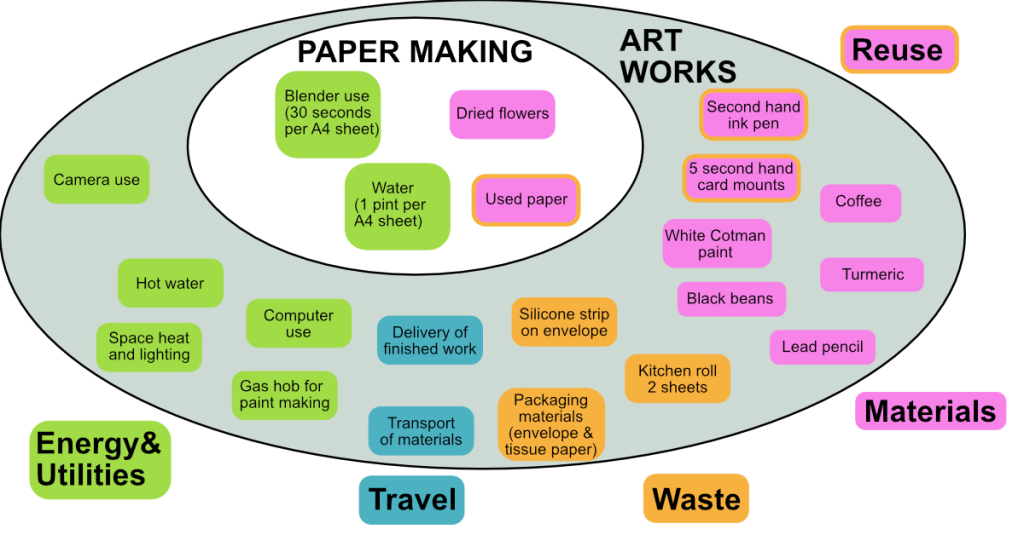
identifying emissions sources in the artist’s work
The next stage of mapping the footprint asks the artist to identify the measurability of emissions and to establish whether they fall under circles of control, influence or concern (adapted from Stephen Covey’s popular business work) in order to identify how they might plan reduction for these emissions.
Control: These are emissions that you pay for and directly cause. Where possible, you can count, monitor and plan to reduce these emissions.
Influence: These are emissions you indirectly cause or have some other influence over. For example, travel you don’t pay for, energy consumption of venues you work in. You can identify who you need to work with for these to reduce and decide whether you could monitor them as part of an extended footprint.
Concern: These are emissions you know about but that you don’t think you (currently) influence. They might include emissions from energy and transport infrastructure, your use of digital or emissions from the supply chains of materials you use. They’re likely to be a longer and harder job to tackle and to reduce them you’ll need to shift the influence circle wider through advocacy and campaigning.
This is what Catriona’s footprint from this process looked like, with some approximations of what the emissions might be for those in the ‘control’ area below.
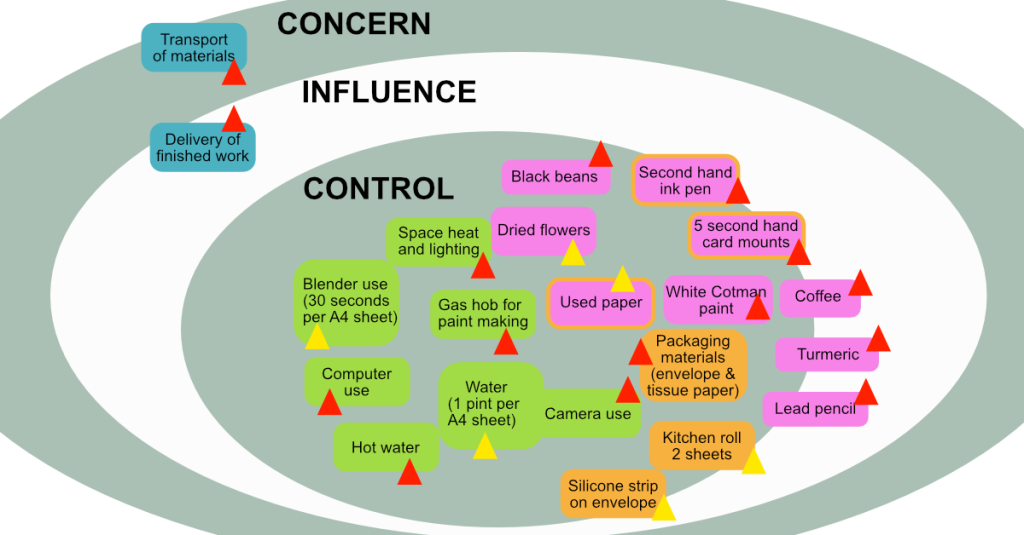
Mapping the footprint of the artwork helps identifies what can be measured and where the opportunities for action are
Estimating Emissions
As identified by Catriona, the majority of emissions sources within her work are either harder to measure with precision (for example computer and camera use) or hard to calculate in carbon terms (for example dried flowers and used paper/junk mail). Below I’ve outlined estimates of emissions from activities and items for which emission factors exist and that could be measured.
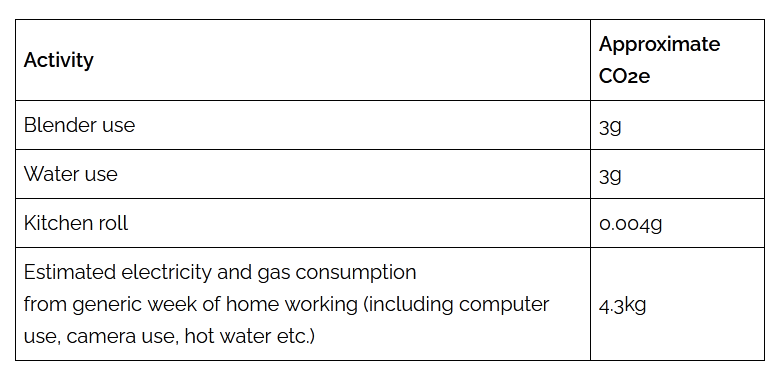
Estimate of emissions from easier to measure activities identified as being within control
You’ll notice that the quantities are diverse and ultimately the total sits at less than 4.5kgCO2e with the majority of emissions coming from the ‘standard’ home working activities such as computer and camera use, lighting and heating.
Footprint Mapping: The value of a qualitative approach
Mapping the footprint using the circles of control, influence and concern gives the capacity to identify emissions sources without requiring precise calculation of every element. As you can see from the initial emissions identification and subsequent calculation of the different elements, the emissions from this work are really very small when compared with the kind of industrial processes that carbon management is often applied to. It doesn’t mean they’re not worth talking about when it’s your world of work, but a qualitative lens as well as a quantitative lens can be useful. Mapping can help establish what’s worth calculating more precisely and what’s possible to change, with space to acknowledge the things that you care about but don’t have direct control over. It gives a fuller picture than a carbon footprint (where one is possible to calculate) and can encourage action beyond the emissions you ‘own’, which for individual artists is a valuable way to look at environmental impact.
Catriona’s own reflection on the process was that it was relatively simple and effective in prompting how she thinks about the different elements of her practice. As a maker and artist, she’s often working to tight deadlines and juggling multiple projects, so time is of the essence when it comes to researching environmental impact. As emerged from the interviews I carried out with artists, Catriona similarly reflected that there is a very real limit to the amount of time you can spend researching a particular element of your environmental impact, so something that gives a quick overview and prompts action can be really useful. While she had already considered a lot of the elements of her environmental impact that this mapping highlighted, she said it helped her to prioritise what she can think about changing next because she could see it in context.
You can find out more about Catriona Patience on her website.
Climate Friendly Culture, Scotland
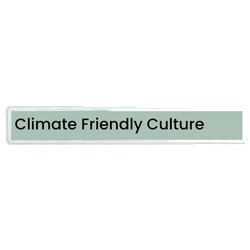
PROFILE
Caro Overy is a musician and sustainability professional exploring the how and why of environmentally sound creative practice. This is a reflective blog of what happens along the way.
Climate Friendly Culture is a development project to learn about the creative community’s response to the climate emergency and explore digital tooling to support this. It is led by Edinburgh-based musician and sustainability professional Caro Overy in partnership with Creative Carbon Scotland and inGenerator and kindly supported by Creative Informatics through the Resident Entrepreneur programme,
Main Research Source
- Low Carbon Devon | Creative Practices that Tread Lightly on the Earth Workshop(21/07/2021)
- Papermaking by Catriona Patience for Climate Friendly Culture(28/05/2021)
I first listened to Caro Overy talk about this project in a zoom meeting – Sustainable Practices Zoom workshop posted on the Green Maker Initiatives resources page: (1:13:40)
Low Carbon Devon | Creative Practices that Tread Lightly on the Earth Workshop
I found this example interesting on several levels.
- Catriona’s work is about nature and reflecting on sustainability
- Her use of recycled paper and homemade colours
- The way it illustrates how an activity can be mapped to examine it’s carbon footprint – it’s much easier to understand a model with a working model you can understand
- The effect the weather has on papermaking!
- The ‘map’ is a quick easy tool to see the environmental impact in context

